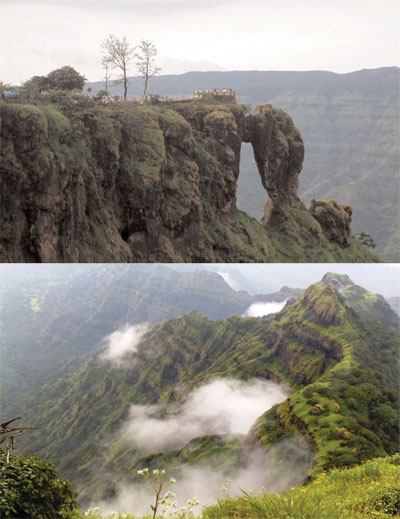
The sweating Mumbaikar has a choice of hill stations, but Mahabaleshwar, eight hours away, tops the list for its cheap lodging, bustling marketplace and strawberry fields. Yet, not many know that this evergreen ‘honeymoon’ spot (what with its secluded points and the enduring thrall of pedal boats) is also home to the discerning shopper. Mahabaleshwar is home to a thriving market for forest honey, turmeric and trousseau saris. Read on to also find out why the residents of that hill station routinely have a great big laugh at us Mumbaikars.
TROUSSEAU IT UP
Mahabaleshwar has been a secret trousseau shopping destination for a few years. Enterprising boutique owners in Vile Parle and other suburbs, buy saris from here, embellish and sell them at inflated rates. The hill station’s 90-year-old shop Pallod, set up by the Pallod family from Rajasthan, is at the centre of this industry. It started off as cloth store, and 20-25 years ago, the second generation of the family started commissioning work (mostly saris) from weavers in Ramnagar (near Benaras), Coimbatore, Arni, Lucknow and Uppada.
With no Octroi and low rent, these saris cost a fraction of what they would in a dazzling store on Juhu-Tara road. Darshan Laddha, a young member of the family, travels 10 days each month to visit the weavers, asking for experimentation like tanchoi weave with Kanjeevaram silk, and returns in time to greet the hordes of customers. Then there is that lone Rajasthani shop without a signboard that sells chiffon Leheriya saris for Rs 300! You heard right.
COMB FOR HONEY
Villagers and tribals of the forests of the Sahyadri gather honey by smoking the bees out of a hive and squeezing the honey out of the comb. The result is a few dead bees, terminated eggs and a homeless swarm. Enterprises such as Sanjeevan Honey practise a more ethical form of extraction. They promote building the hive in a wooden box, with a sly opening for the bees.
The combs are built on trays that slide out. These trays are fitted to an extraction machine (see below) which is hand churned and uses centrifugal force to extract the honey without destroying the combs. The trays go back into the box, and the bees repair cells that may have broken to resume the honey-making process. V R Agarkar, who left Dapoli for the hills of Mahabaleshwar 50 years ago, is happy to give you a tour and explain the honey-making process. The 72-year-old loves explaining how bees like to keep their comb clean. “If I drop a piece of paper, they’ll shred it and I’ll find it outside the box the next day,” he adds. You’ll usually find him at the stall adjoining Kedar Residency.
WAI TURMERIC? BECAUSE IT’S GOOD
Wai is to the south of Mahabaleshwar. It’s the place to buy unadulterated turmeric. In drought-prone Maharashtra, turmeric is a highmaintenance crop. With the Krishna river flowing nearby, about 2,000 to 2,500 hectares of farmland grow the antiseptic root. It is harvested in December, laid out to dry, then polished and ground. By next week, the farmers will start sowing the crop, again.
Two to four kilos of wet root yield a kilo of turmeric powder. Most of the crop would be sold to merchants, who would then supply it to the market places of Satara. “In the past few years, the price offered for our crop has fallen, so we have been grinding the turmeric on our own and selling it on the highway,” says Mangal Zamdale, a farmer. Tables set up under flowering Gulmohars that line the Satara highway sell fresh turmeric powder, pickles, and papads. A spicy way to offset the sweetness of the strawberries you’ve eaten, perhaps?
GOTCHA, MUMBAIKAR
It is a truth universally accepted that Mahabaleshwar makes leather chappals that populate the shelves of large shoe store chains in Mumbai. However, that is also an assumption that Mahabaleshwar is in no hurry to correct. The fact is that very few workshops in the hill station still produce chappals the Mahabaleshwar way (not to be confused with a Kolhapuri), which is to soak the leather in sea salt to bleach and dehydrate it.
The theory is that the leather then absorbs our sweat easily. However, most of what we take back as souvenirs is actually brought in from Dharavi and small-scale industries of Tilak Nagar, Bandra and Santacruz. Yes, Mahabaleshwar is laughing at us. AS Karande of New India Boothouse in Mahabaleshwar, however, still makes the chappals. You can see him at work in his shop. Hemant, Prabhat and Hind shoe marts have workshops, too. To Hemant’s workshop come experienced craftsmen like Nana Kadam, who travels over 35 kilometres one way, every day. He is one of the old hands who knows how to punch in the design that makes a tadgola chappal.
GETTING THERE
Mahabaleshwar is 247 km from Mumbai. You can drive down the Satara highway, and hit Wai and Panchgani en route. Buses, private and state-owned also ply regularly. There is a train to Satara, an hour from Mahabaleshwar.





Be the first to comment